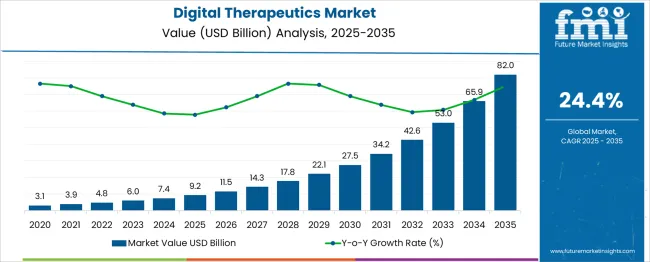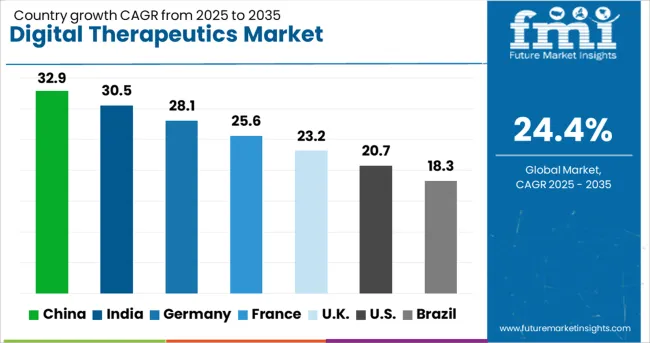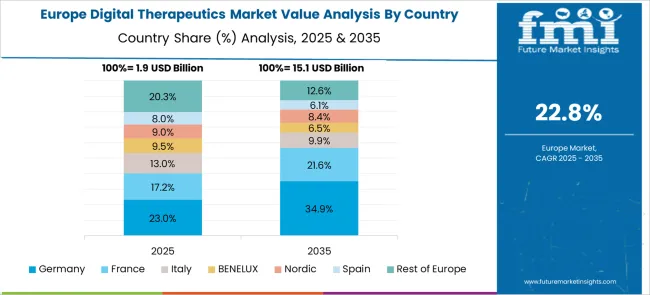The Digital Therapeutics Market is estimated to be valued at USD 9.2 billion in 2025 and is projected to reach USD 82.0 billion by 2035, registering a compound annual growth rate (CAGR) of 24.4% over the forecast period.

| Metric | Value |
|---|---|
| Digital Therapeutics Market Estimated Value in (2025 E) | USD 9.2 billion |
| Digital Therapeutics Market Forecast Value in (2035 F) | USD 82.0 billion |
| Forecast CAGR (2025 to 2035) | 24.4% |
The digital therapeutics market grew at a CAGR of 22.0% between 209.27 and 2035.2. The market value for global digital therapeutics held nearly 2.7% of the overall USD 9.246 Billion digital health market in 2035.2.
The power of mobile technology to capture and hold people's attention is well known. A rising number of start-ups and established technology players are betting on that power to help people enhance their health outcomes in measurable ways.
These companies are driving software and health-care convergence in ways that can potentially change how the conventional approach of the life sciences industry, which involves both large pharma companies and medical technology or medical device companies, supports the patient health-care journey from beginning to end, spawning a new branch of medicine known as digital therapeutics.
Conventional therapies and treatments are still unable to meet unmet patient demand, while digital medicines offer the potential to do so. Enterprises that use digital therapies to close these gaps, together with substantially shorter product development timetables, may have a considerable edge over traditional life sciences companies.
Rising prevalence of preventable chronic diseases, the pressing need to regulate the cost of health care, a need for safe and accessible workarounds for the treatment of chronic and mental health diseases, a growing focus on predictive, preventative, personalised, and participatory healthcare, increasing investments in digital therapeutics are driving growth in the digital therapeutics market.
Digital therapeutics provide patient-oriented solutions through aspects such as digital behavioural interventions to devise evidence-based solutions on patient data, artificial intelligence and machine learning interventions, mobile health applications, gamification, and virtual reality. Driven by this, the market is expected to grow at a 24.4% CAGR and offer an absolute $ opportunity of nearly USD 9.2 Billion between 2025 and 2025.
Numerous start-ups and existing technology companies are banking on the ability of mobile technology to help people improve their health in quantifiable ways. Manufacturers are driving software and healthcare convergence in ways that are expected to change the life sciences industry's traditional approach, which includes both large pharma and medical technology or medical device companies, supports the patient's medical journey. This has spawned a new branch of medicine known as digital therapeutics and will provide lucrative opportunities for growth over the forecast period.
Furthermore, digital therapeutics provide pharmaceutical and MedTech businesses with a low-cost approach to differentiate products, especially when compared to the research and development costs generally involved with traditional medicine or medical device.
Many businesses are refocusing their R&D efforts away from core product lines and toward revolutionary innovation. Digital medicines also have the potential to lengthen product life cycles, differentiate in-development goods, and cover market gaps that traditional medicine may not be able to fill. All these factors are expected to augment the growth in the market over the assessment period.
Wearable healthcare faces several challenges, including the fact that the data provided cannot always be used to track, diagnose, and treat health disorders due to ongoing concerns about data accuracy, consistency, and privacy.
Additionally, stakeholder awareness, acceptance, and engagement are issues for many firms that have joined the DTx industry. Most DTx solutions have entered the market with product-centric revenue models and go-to-market strategies to date.
Instead of satisfying unmet requirements of patients and other essential stakeholders across the end-to-end continuum of care, their focus has been on selling more products. As a result, the market for isolated digital point solutions is fragmented, confused, and overcrowded. There is no genuinely comprehensive, patient-centric experience to assist patients in navigating the present complex healthcare system.
As a result of the additional time and money spent on product development, the marketing and commercial sales teams are underp ressure to produce successful go-to-market plans for DTx launch, scale-up, and growth. These factors, together, induce a restrictive impact upon the growth of the overall digital therapeutics market.


Rapid Adoption of Connective Technology-Based Medical Equipment Will Fuel Sales of Digital Therapeutics
The USA dominated the North America digital therapeutics market in 2024, holding about 90.3% of the market share. As per FMI, the trend is projected to continue over the forecast period. Growth is associated with the high burden of chronic disease in the general population within the country.
Increasing incidence of gastrointestinal and central nervous system diseases is underpinning the demand for digital therapeutics. With growing adoption of telemedicine, integration and adoption of mobile health analytics in the USA, sales are expected to increase over the forecast period.
Growing Demand for Digital Therapeutics for Insomnia Will Augment Growth
China is expected to account for 48.0% of the East Asia digital therapeutics market share in 2025. After the third wave of automation and digital technology integration propelled by the advent of the COVID-19 pandemic, China has established full automation solutions for medical and production facilities.
The local government has joined forces with leading DTx organisations with a joint commitment of 20 billion RMB ($32 billion) in funding support to formalise a massive DTx Industrial Park project, which is a promising indicator of Chinese DTx market progress. The project's details and funding proposal have yet to be revealed, but a newly built DTx Industrial Park in Zhejiang Province will soon serve as the DTx industrial flagship in China.

Rising Awareness Regarding Digital Therapeutics Technology Will Boost Sales in Germany
With a high volume of the disease burden associated with chronic ailments such as cardiovascular diseases, diabetes, and cancer, demand for digital therapeutics in Germany is anticipated to remain high. As per the report, the Germany digital therapeutics market will expand at a 20.6% CAGR over the forecast period.
In 2020, the German Parliament passed the Digital Healthcare Act (DigitaleVersorgung-Gesetz, or DVG), allowing all German doctors to prescribe digital treatments to publicly-insured patients in Germany. This has enhanced the accessibility of safe digital solutions for the treatment of chronic and mental health diseases.
Demand for Combination Therapy Will Gain Traction
Based on solution, the combination therapy segment is projected to account for 68.4% of the total market share in 2025. Combination therapy with biopharmaceuticals, or “smart drugs” offers an exciting way to improve patient adherence and outcomes. Pharmaceutical companies can assist patients in improving their health outcomes by digitising drugs and utilising digital interventions to encourage their proper usage.
Adoption of Digital Therapeutics for Disease Prevention Will Rise
In terms of applications, the prevention segment is forecast to hold 35.8% of the total market share in 2025. For patients at risk of developing more serious ailments, digital therapeutics are routinely used as a prophylactic measure. These prevention measures provide approaches and solutions that could delay the onset of the chronic disease.
Sales of Digital Therapeutics for Central Nervous Systems Disorders Will Boost Demand
By indication, sales in the central nervous system disorders segment will increase at a CAGR of 29.2% over the assessment period. Several drugs that are now in use were discovered as a result of drug discovery research intended to treat central nervous system (CNS) illnesses.
However, not all drugs can relieve patients of the symptoms of their disorders, and CNS dysfunction is still a medical area with many unmet needs. Medical solutions which utilize digital technologies can address these unmet needs.
Sales of Digital Therapeutics Direct to Patients Will Gain Momentum
Based on distribution channel, the direct-to-patients/consumers segment will hold about 60.1% of the total market share over the forecast period. With the products being sold directly to the consumer, the availability of mobile health solutions provide customers with solutions linked to enhanced patient compliance and better clinical outcomes.

The market for digital therapeutics is a fragmented. With the emergence of start-ups and other market players, the global market is likely to witness the heavy competition. Companies are aiming to launch digital health campaigns and software solutions for a comprehensive patient care regimen. For instance:
| Attribute | Details |
|---|---|
| Forecast Period | 2025 to 2035 |
| Historical Data Available for | 2020 to 2024 |
| Market Analysis | USD Billion for Value |
| Key Regions Covered | North America, Latin America, Europe, South Asia, East Asia, Oceania, Middle East and Africa (MEA) |
| Key Countries Covered | The USA., Canada, Brazil, Mexico, Argentina, Germany, Italy, France, Spain, the UK., Russia, BENELUX, China, Japan, South Korea, India, Indonesia, Thailand, Malaysia, Australia, New Zealand, GCC Countries and Turkey |
| Key Companies Covered | Teladoc Health ;Inc.; Click Therapeutics, Inc.; Welldoc; HYGIEIA; DarioHealth Corp; BigHealth; Orexo AB; Akili Interactive Labs, Inc.; Freespira; Voluntis; Kaia Health; Kaiku Health; Theranica Bio-Electronics Ltd.; Propeller Health; Orexo US, Inc.; TALi Digital Limited; Limbix Health, Inc. |
| Key Market Segments Covered | Solution, Application, Indication, Business Model and Region |
The global digital therapeutics market is estimated to be valued at USD 9.2 billion in 2025.
The market size for the digital therapeutics market is projected to reach USD 82.0 billion by 2035.
The digital therapeutics market is expected to grow at a 24.4% CAGR between 2025 and 2035.
The key product types in digital therapeutics market are monotherapy and combination therapy.
In terms of application, prevention segment to command 42.6% share in the digital therapeutics market in 2025.






Full Research Suite comprises of:
Market outlook & trends analysis
Interviews & case studies
Strategic recommendations
Vendor profiles & capabilities analysis
5-year forecasts
8 regions and 60+ country-level data splits
Market segment data splits
12 months of continuous data updates
DELIVERED AS:
PDF EXCEL ONLINE
Digital Therapeutics and Wellness Market Size and Share Forecast Outlook 2025 to 2035
Digital Psychotherapeutics Market Size and Share Forecast Outlook 2025 to 2035
Neurology Digital Therapeutics Market Growth – Trends & Forecast 2024-2034
Digital Rights Management Market Size and Share Forecast Outlook 2025 to 2035
Digital Liquid Filling Systems Market Size and Share Forecast Outlook 2025 to 2035
Digital Transformation Industry Analysis in MENA Size and Share Forecast Outlook 2025 to 2035
Digital X-Ray Equipment Market Size and Share Forecast Outlook 2025 to 2035
Digital Marketing Analytics Industry Analysis in Latin America Forecast Outlook 2025 to 2035
Digital Health Market Forecast and Outlook 2025 to 2035
Digital Pen Market Forecast and Outlook 2025 to 2035
Digital X-ray Market Size and Share Forecast Outlook 2025 to 2035
Digital Elevation Model Market Size and Share Forecast Outlook 2025 to 2035
Digital Pump Controller Market Size and Share Forecast Outlook 2025 to 2035
Digital Textile Printing Market Size and Share Forecast Outlook 2025 to 2035
Digital Printing Paper Market Size and Share Forecast Outlook 2025 to 2035
Digital Battlefield Market Size and Share Forecast Outlook 2025 to 2035
Digital Product Passport Software Market Size and Share Forecast Outlook 2025 to 2035
Digital Lending Platform Market Size and Share Forecast Outlook 2025 to 2035
Digital Shipyard Market Size and Share Forecast Outlook 2025 to 2035
Digital Freight Matching Market Size and Share Forecast Outlook 2025 to 2035

Thank you!
You will receive an email from our Business Development Manager. Please be sure to check your SPAM/JUNK folder too.
Chat With
MaRIA